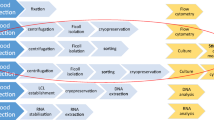Abstract
This study aimed to investigate the expression of protease-activated receptors (PARs) on platelets in healthy individuals and preliminarily elucidate physiological functions of PARs. Thirty healthy volunteers, who did not take any anticoagulants and antiplatelet agents within 10 days before the examination, were recruited. Fasting venous blood (5 mL) was taken from the medial cubital vein in each individual and platelet-rich plasma (PRP) was prepared. The expression of PAR1 mRNA and PAR4 mRNA in PRP was determined by RT-PCR analysis. The results showed that the average levels of PAR1 mRNA and PAR4 mRNA on platelets in healthy individuals were 0.1601 ± 0.0269 and 0.1073 ± 0.0194 respectively. In combination with literature analysis, it was concluded that the thrombin signaling pathway plays a vital role in the development of hemostasis and thrombosis, and the selective PARs antagonist has the potential for extensive application in clinical practice.
Similar content being viewed by others
References
Ruggeri Z M. Platelets in atherothrombosis. Nat Med, 2002, 8(11): 1227–1234
Kahn M L, Zheng Y W, Huang W, Bigornia V, Zeng D, Moff S, Farese R VJr, Tam C, Coughlin S R. A dual thrombin receptor system for platelet activation. Nature, 1998, 394(6694): 690–694
Coughlin S R. How the protease thrombin talks to cells. Proc Natl Acad Sci USA, 1999, 96(20): 11023–11027
Macfarlane S R, Seatter M J, Kanke T, Hunter G D, Plevin R. Proteinase-activated receptors. Pharmacol Rev, 2001, 53(2): 245–282
Faruqi T R, Weiss E J, Shapiro M J, Huang W, Coughlin S R. Structure-function analysis of protease-activated receptor 4 tethered ligand peptides. Determinants of specificity and utility in assays of receptor function. J Biol Chem, 2000, 275(26): 19728–19734
Hamilton J R, Frauman A G, Cocks T M. Increased expression of protease-activated receptor-2 (PAR2) and PAR4 in human coronary artery by inflammatory stimuli unveils endothelium-dependent relaxations to PAR2 and PAR4 agonists. Circ Res, 2001, 89(1): 92–98
Coughlin S R. Thrombin signalling and protease-activated receptors. Nature, 2000, 407(6801): 258–264
Kahn M L, Nakanishi-Matsui M, Shapiro M J, Ishihara H, Coughlin S R. Protease-activated receptors 1 and 4 mediate activation of human platelets by thrombin. J Clin Invest, 1999, 103(6): 879–887
Vu T K, Hung D T, Wheaton V I, Coughlin S R. Molecular cloning of a functional thrombin receptor reveals a novel proteolytic mechanism of receptor activation. Cell, 1991, 64(6): 1057–1068
Chen J, Ishii M, Wang L, Ishii K, Coughlin S R. Thrombin receptor activation: confirmation of the intramolecular tethered liganding hypothesis and discovery of an alternative liganding mode. J Biol Chem, 1994, 269(23): 16041–16045
Reed G L. Platelet secretory mechanisms. Semin Thromb Hemost, 2004, 30(4): 441–450
Dorsam R T, Kunapuli S P. Central role of the P2Y12 receptor in platelet activation. J Clin Invest, 2004, 113(3): 340–345
Cook J J, Sitko G R, Bednar B, Condra C, Mellott M J, Feng D M, Nutt R F, Shafer J A, Gould R J, Connolly TM. An antibody against the exosite of the cloned thrombin receptor inhibits experimental arterial thrombosis in the African green monkey. Circulation, 1995, 91(12): 2961–2971
Sambrano G R, Weiss E J, Zheng Y W, Huang W, Coughlin S R. Role of thrombin signalling in platelets in haemostasis and thrombosis. Nature, 2001, 413(6851): 74–78
Pakala R, Liang C T, Benedict C R. Inhibition of arterial thrombosis by a peptide ligand of the thrombin receptor. Thromb Res, 2000, 100(1): 89–96
Hasan A A, Rebello S S, Smith E, Srikanth S, Werns S, Driscoll E, Faul J, Brenner D, Normolle D, Lucchesi B R, Schmaier A H. Thrombostatin inhibits induced canine coronary thrombosis. Thromb Haemost, 1999, 82(3): 1182–1187
Connolly TM, Condra C, Feng DM, Cook J J, Stranieri MT, Reilly C F, Nutt R F, Gould R J. Species variability in platelet and other cellular responsiveness to thrombin receptor-derived peptides. Thromb Haemost, 1994, 72(4): 627–633
Derian C K, Santulli R J, Tomko K A, Haertlein B J, Andrade-Gordon P. Species differences in platelet responses to thrombin and SFLLRN. Receptor-mediated calcium mobilization and aggregation and regulation by protein kinases. Thromb Res, 1995, 78(6): 505–519
Zhang H C, Derian C K, Andrade-Gordon P, Hoekstra W J, McComsey D F, White K B, Poulter B L, Addo M F, Cheung WM, Damiano B P, Oksenberg D, Reynolds E E, Pandey A, Scarborough R M, Maryanoff B E. Discovery and optimization of a novel series of thrombin receptor (par-1) antagonists: potent, selective peptide mimetics based on indole and indazole templates. J Med Chem, 2001, 44(7): 1021–1024
Andrade-Gordon P, Derian C K, Maryanoff B E, Zhang H C, Addo M F, Cheung W M, Damiano B P, D’Andrea M R, Darrow A L, de Garavilla L, Eckardt A J, Giardino E C, Haertlein B J, McComsey D F. Administration of a potent antagonist of protease-activated receptor-1 (PAR-1) attenuates vascular restenosis following balloon angioplasty in rats. J Pharmacol Exp Ther, 2001, 298(1): 34–42
Derian C K, Damiano B P, Addo M F, Darrow A L, D’Andrea M R, Nedelman M, Zhang H C, Maryanoff B E, Andrade-Gordon P. Blockade of the thrombin receptor protease-activated receptor-1 with a small-molecule antagonist prevents thrombus formation and vascular occlusion in nonhuman primates. J Pharmacol Exp Ther, 2003, 304(2): 855–861
Ahn H S, Foster C, Boykow G, Stamford A, Manna M, Graziano M. Inhibition of cellular action of thrombin by N3-cyclopropyl-7-[[4-(1-methylethyl)phenyl]methyl]-7H-pyrrolo[3, 2-f]quinazoline-1,3-diamine (SCH 79797), a nonpeptide thrombin receptor antagonist. Biochem Pharmacol, 2000, 60(10): 1425–1434
Author information
Authors and Affiliations
Corresponding author
Rights and permissions
About this article
Cite this article
Zhu, R., Shen, L. Expression of protease-activated receptors on platelets in healthy individuals. Front. Med. China 3, 236–239 (2009). https://doi.org/10.1007/s11684-009-0040-7
Received:
Accepted:
Published:
Issue Date:
DOI: https://doi.org/10.1007/s11684-009-0040-7




